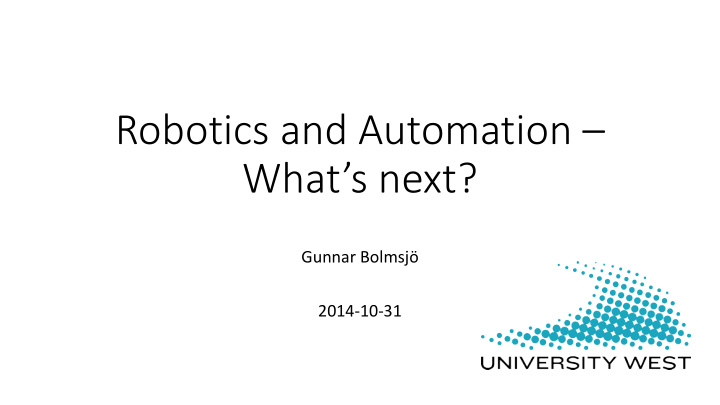



Robotics and Automation – What’s next? Gunnar Bolmsjö 2014-10-31
Background • Efficient manufacturing provides products at low cost for people • Developments during WWII generated important technologies • Servo control • Computers • Computer controlled machines and robots scale up • Capacity, productivity • Power exerted during operations • Demographics • Productivity increase vs. demand increase? • What’s Next? 2014-11-16 GB 2
What does a childbearing below the replacement fertility rate mean? • Fertility rate of approx. 1.9 child per woman • The population decreases to approx. 80 percent after 100 years • Fertility rate of approx. 1.3 child per woman • The population decreases to approx. 25 percent after 100 years • Fertility rate of 1.5 child per woman • Critical level to sustain population balance through immigration and society ass a whole (Source: Mc Donald P. (2000) Gender equity, social institutions and the future of fertility) • BUT: what about consumption, way of life, trust in society and welfare? 2014-11-24 3
What’s next? • Robot soldiers • Robot hands • Power, control and cognitive capabilities • Collaboration human – robot and safe operation work scenarios • Explore the unknown: Flagship projects like “Graphene” and “The Human Brain” • Produce on demand, anywhere, low waste, controlled quality, low cost • Examples from Automatics: two arms, high speed examples, Justin, iCube, schunk hand, robot soldier one movie 2014-11-16 GB 4
Automation a and aut uton onom omy y – some e e examples es 2014-10-31 GB 5
Man vs. Machine – developments over time 34 km drive in 2 days 7.3 and 11.6 km in 3.5 years The first geologist and scientist brought home superior samples from the moon Apollo 17, 1972 Spirit and Opportunity, Mars, 2004 2014-10-31 GB 6
Autonomy, adaptive control, drones… • Audi drive in automatic mode at Hockenheim Oct 2014 • Autonomous control provides tremendous opportunities • Can drone technology be part of production? • What are the limits? • How will this technology change society, market, behavior? 2014-10-31 GB 7
Drones and services… • DHL and Deutsche Post test fast delivery to an island 12 km in the sea • Idea: Can this be implemented in a factory to transport goods between machines or robots? 2014-10-31 GB 8
R&D i in n man any ar y areas “Joi oin n For orces” i in n Aut Automation and and Robot obotics cs 2014-10-31 GB 10
From mass production to mass customization • Human – machine collaboration • Smart robots, or robots as a co- worker • Additive manufacturing • Internet of Things – know your goods • Big data – know what happens with you goods Collaboration mode • Cyber Physical Systems – take Photo: GB control over your goods 2014-10-31 GB 11
Standardization Öresund bridge at sunset • Deploy in a harmonized Photo: GB way • “Best practice” • Global reach • Everything can be made everywhere – in theory 2014-11-16 GB 12
New materials – new opportunities • Graphene BMW i8 Photo: GB • The Human Brain Project • Genetics • Hybrid and composite materials • Additive processes • Joining principles – combining materials • Speed in the innovation process is greater than ever before 2014-10-31 GB 13
Man anufactu cturi ring i in f n focu cus: s: What i t is thi his? s? P Pol oliti tics, s, or or wha hat? t? 2014-10-31 GB 14
It’s about global competition • Protecting the welfare state • Compete in producing goods and services on a globalized market • Attract people – the future will see a demand for skill and competence • Create a sustainable society built on stability, trust and safety One example: • Money earned for retirement is in reality just numbers on a paper • The big question is: What can you actually buy for these numbers in 10, 20, 30 years? • What are you interested in buying? 2014-10-31 GB 15
Similar programs elsewhere? Leadership in Manufacturing: • Industrie 4.0 (Germany) • Made in the USA – actions by the Obama administration to address R&D in manufacturing in the USA • Horizon 2020 – the largest R&D program in the world. Also addressing production and related areas • SIO production and similar initiatives in Sweden 2014-10-31 GB 16
Tren ends a and reflection 2014-10-31 GB 17
Fierce and global competition Skill and competence – a key to success in the future Speed of change is an irritating important factor today and more in the future Sustainable manufacturing, industrial services and mass customization Can demand increase balance increase in productivity ? 2014-10-31 GB 18
From symmetry to asymmetry • In the past: • A work or product was valued in relation to the effort (physical or in time) to make the product or service • In the near future: • A work or product will be valued related to functions provided, and no or little connection to resources spent for producing the product or service • A few will get all revenue • how will this affect consumers? • How will “hard to automate” services survive? 2014-11-16 GB 19
Conclusions • R&D from many areas “join forces” into automation and robotics • Cognitive capabilities multiply the use of future robots • Collaboration between human and robot(s) combines skill, power and control • New materials and processes will provide new and unknown opportunities • Automation has a global outreach today – any cost, any market (if quality matters) • The local view: buy robots and outcompete others! • The global view: do we need all products and services provided? 2014-11-16 GB 20
Recommend
More recommend